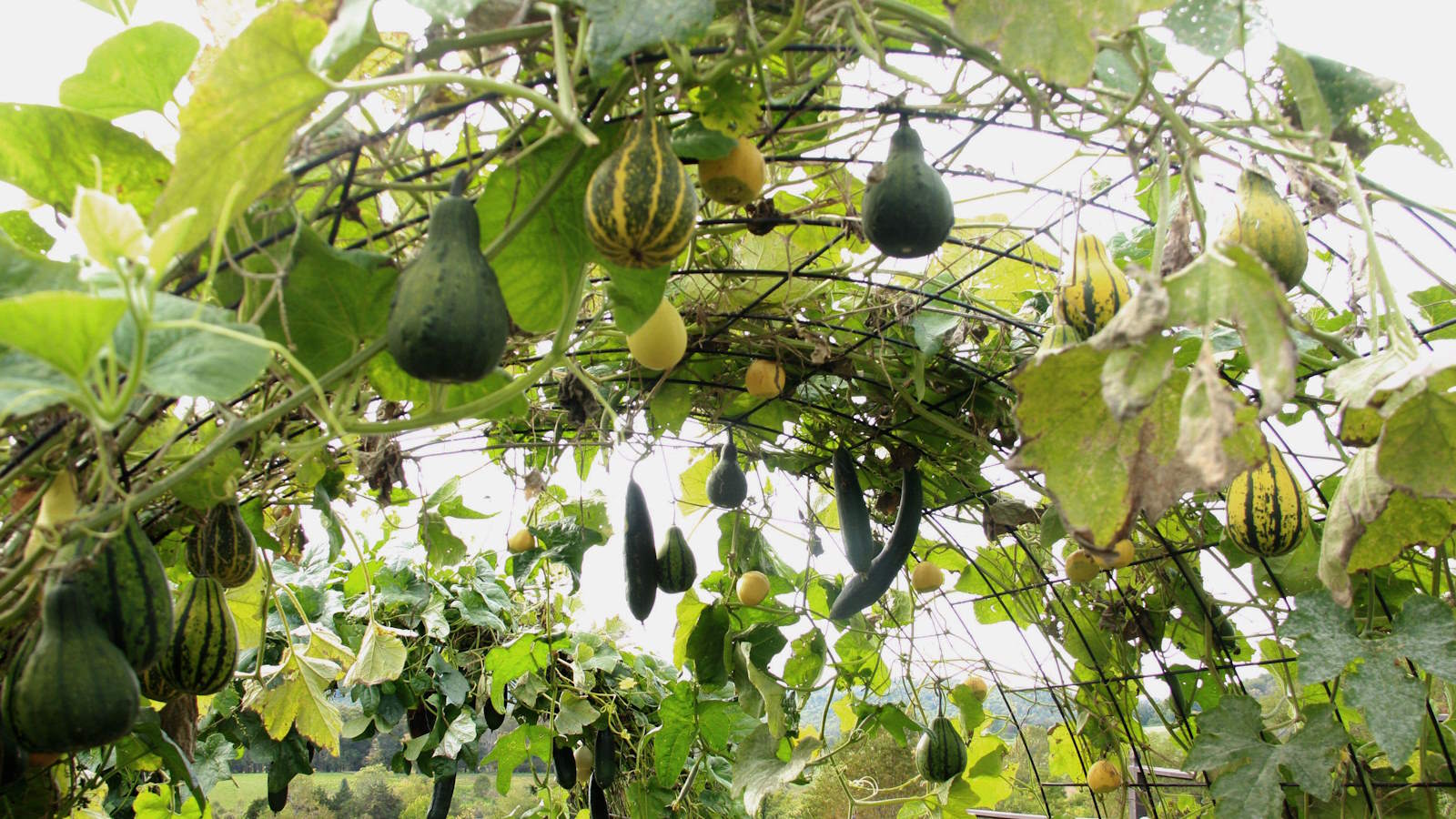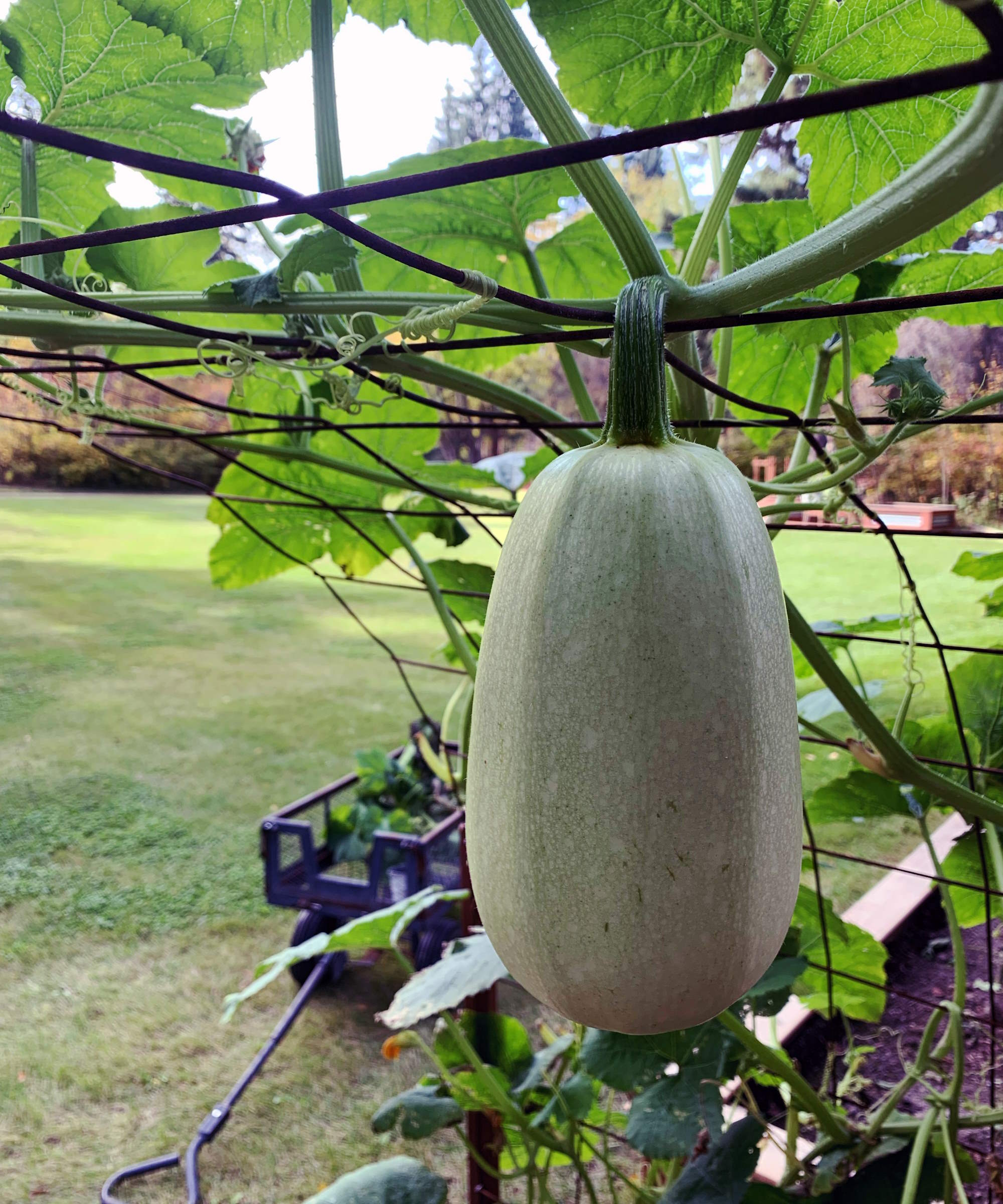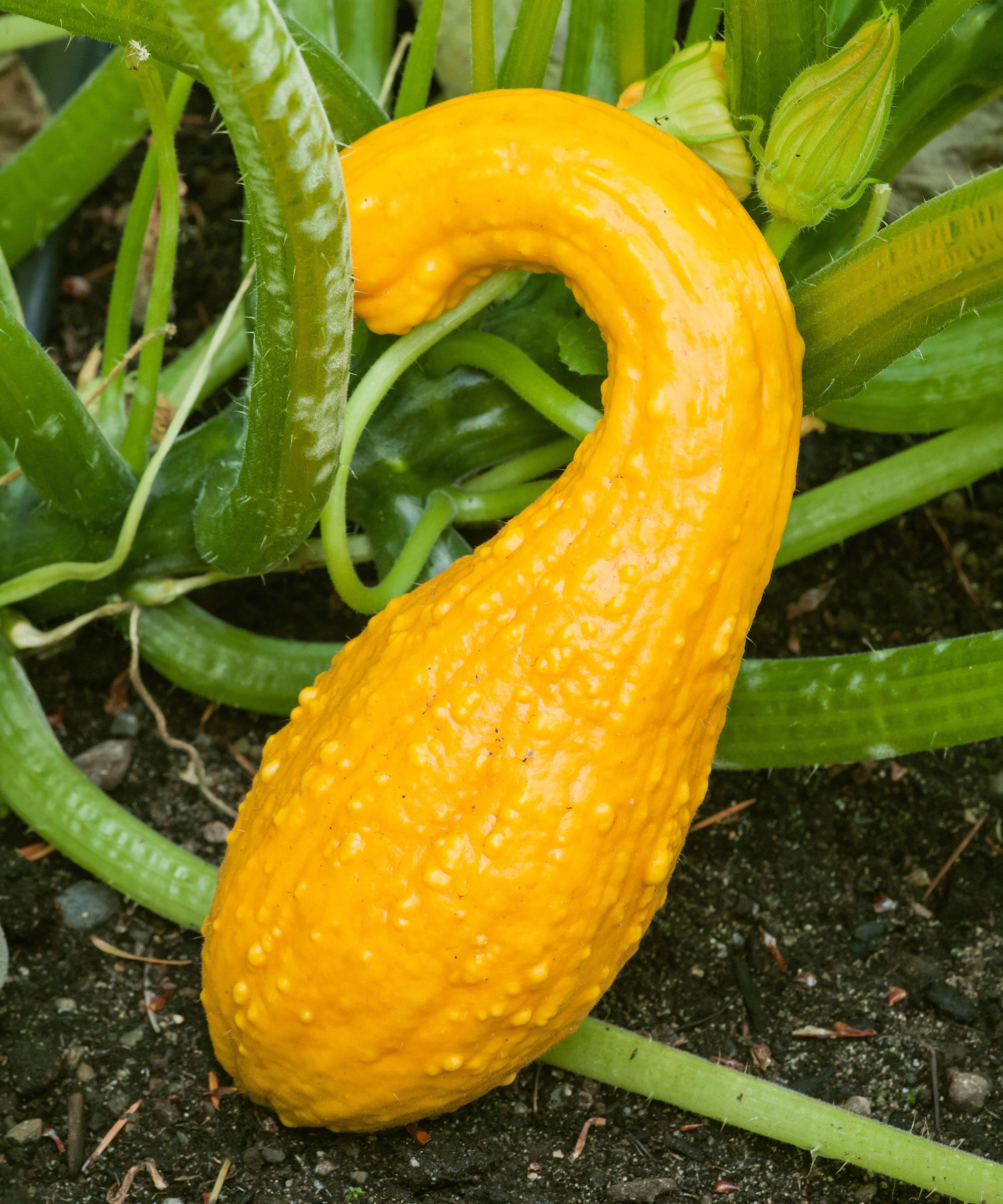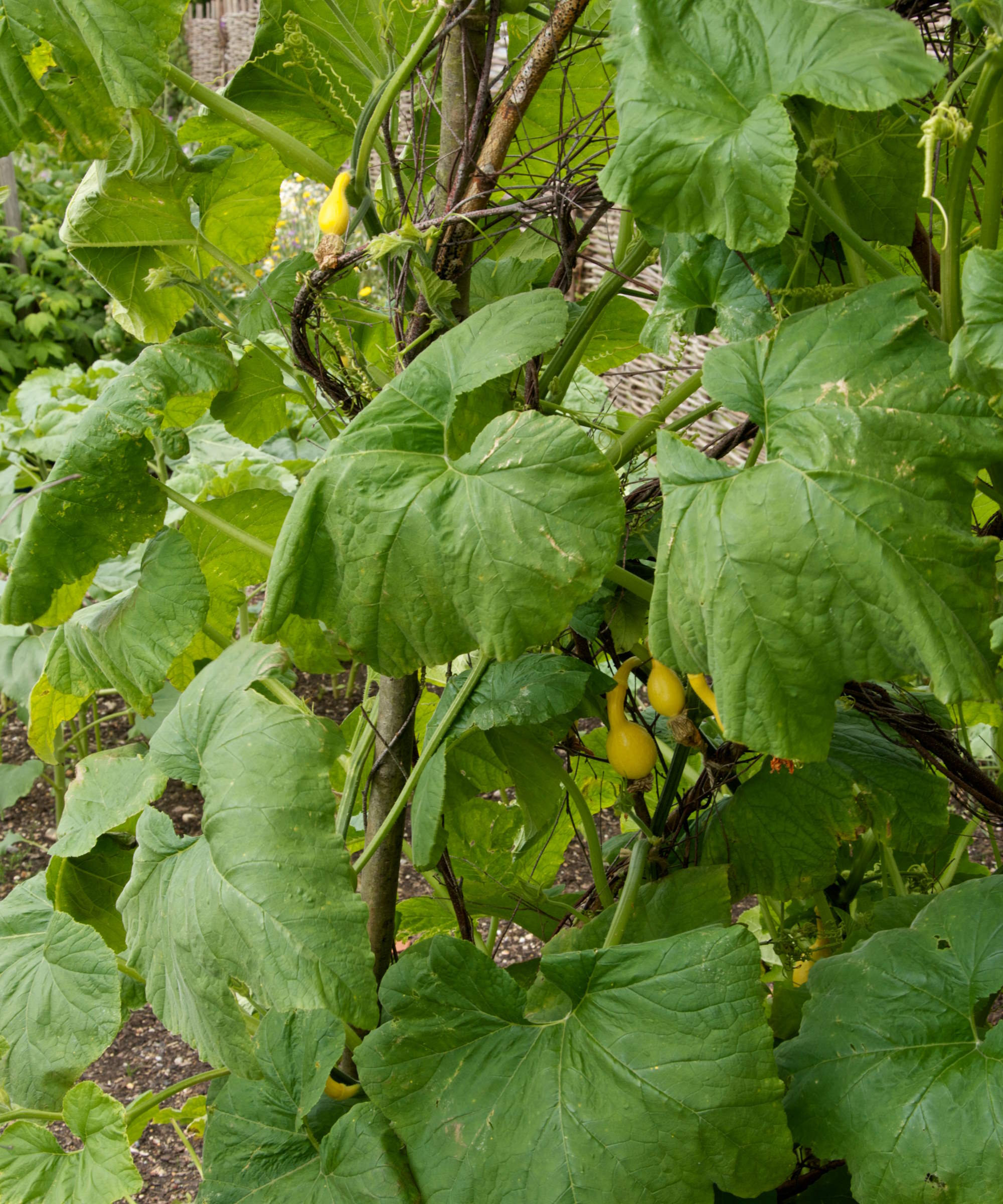How to grow squash vertically – save space and create a feature in your vegetable garden
Vertically growing squash on a trellis or arch is becoming increasingly popular as gardeners discover the benefits that it offers - are you tempted to join in too?


Do you want to grow squash plants but find yourself short of the space to allow the vines to spread like you see in most vegetable gardens? Then you could consider growing squash vertically and taking advantage of the space-saving benefits on offer.
You do not need lots of ground space to grow squash, as you can train these easy-to-grow and prolific plants upwards. Many of the most popular varieties of squash can thrive growing vertically and it makes a feature in the garden as well as providing a great harvest of fruits.
It does not even need to be just for those with little space, as it can also be an efficient way of saving precious bed space on an existing plot. Training squash plants over arches or up supports means you have more space to grow other vegetables, flowers, or herbs in a kitchen garden.

Spaghetti squash are great candidates for growing vertically
Can you grow squash vertically?
Squash is a crop perfectly suited to being trained to grow vertically as part of people’s vegetable garden ideas. To help inspire you to try vertically growing squash, we take a closer look at the benefits it offers and how you can train many different types of squash to grow in this way.
Advantages of vertically growing squash

Growing squash vertically raises fruits off the ground - away from pests
There are many advantages to creating a vertical garden and choosing to grow crops upwards on a trellis system rather than leave them to sprawl over the vegetable garden. It is a way to grow squash and grow pumpkins, and growing cucumbers vertically is also popular among many growers.
The primary advantage is space-saving, it makes efficient use of limited space and reduces the ground area needed for crops that otherwise sprawl. It makes growing squash more possible in limited space, such as people with small vegetable gardens or who grow their crops in tighter urban spaces, as well as potentially opening up space to grow other crops rather than have one plant that requires such a large footprint on the plot.
Squash growing vertically also benefits health-wise from better air circulation through the plants, which reduces the risk of fungal diseases that can turn squash leaves yellow, and the fact they are raised away from pests on the ground.
Design expertise in your inbox – from inspiring decorating ideas and beautiful celebrity homes to practical gardening advice and shopping round-ups.
As well as taking up less space and being healthier, vertically growing squash can make the fruits easier to spot and harvest and the vines growing upwards offer aesthetic benefits to any kitchen garden.
Types of squash for growing vertically

There are many different types of squash that can prosper being grown vertically
There are many different types of squashes you can choose to grow in any vegetable garden. Squashes come in different shapes, sizes, and growth habits - and not all are going to be ideally suited to growing vertically.
Compact types of summer squash make good contenders for vertical growth. Types such as ‘Zucchini’ and ‘Patty Pan’ are more compact and bush-growing varieties that are suited to growing vertically due to their size. Curved squash like 'Trombetta di Albenga' or 'Tromboncino' are vining summer types that can happily climb trellises and their long and thin fruits will look spectacular hanging in the air.
Winter squash varieties do tend to be larger than summer types and will need more sturdy supports, but many remain perfectly suited to growing vertically. The likes of ‘Butternut Squash’, ‘Acorn’, or ‘Spaghetti Squash’ grow to a manageable size for climbing.
Discover the range of squash varieties to grow available at Burpee
Steps to grow squash vertically

A homemade trellis can be strong enough to grow squash vertically
The first step is to choose the right location in the garden. The squash plants want a sunny spot that can get at least six hours of sunlight a day, and they also want fertile soil type. However, squash plants climbing vertically can shade other plants, so make sure to choose a spot where it won't affect the growth of other crops in your garden.
You then want to pick the support structure that you will utilize to vertically grow squash plants throughout the season. There are many different potential designs you can choose, but it does need to be strong, so Tony O'Neill, gardening expert and author, recommends: ‘Use a strong trellis, arbour, or sturdy netting that can support the weight of the squash vines and fruits. Ensure the structure is anchored securely to withstand the additional weight.’
It is best to think about the structure and get it put in place early in the season, around the same time you choose your type of squash and order seeds in the spring.
Squash plants can be sown indoors in spring early to transplant out into the garden at the base of the support. Alternatively, squash seeds can be sown outdoors once the soil warms up. Young plants or seeds should be planted at the recommended spacing for the variety. The danger of attempting to put the structure in place after planting or sowing seeds is that there will be a real risk of damaging the young plants as they are growing.
Keep the young plants well watered, and the ground consistently moist, and the squash should grow quickly.
Robin Phelps, gardening coach for Sow Many Plants, advises: ‘As the plants grow, gently guide the vines upward, securing them to the support with soft ties.’ As the squash plants grow, the vines should be regularly tied and Robin also recommends pruning squash plants to ‘remove excess foliage to promote airflow and prevent overcrowding’.

Robin Phelps is a Gardening and Preserving Coach at Sow Many Plants, with over 20 years of experience in the gardening industry. She specializes in growing fruit and vegetables, with a dedication to teach others how to preserve and keep what they grow.
How to train squash to grow vertically

Tie in and train the vines often to keep them supported as they grow
Begin training and tying the vines to the support structure when the plants are young. At this stage, they are more flexible and can be encouraged to climb without risking snapping the precious stems.
Always use soft ties to secure the plant to the structure, this can include string, clips, plastic flexible ties, or cloth strips. Soft ties can support the plant and also cushion it as it grows or moves in the wind. Using hard ties, or metal ones, that do not allow for movement can damage plant stems and risk snapping them. Any ties that you use should be regularly checked for signs of damage and adjusted to accommodate the growth of the vines.
The plant should be attached to the support regularly and new growth has to be encouraged upwards. The vines can be both tied and woven through the trellis itself to keep the weight evenly distributed and the plant upright. When fruits are forming, further support may be required to cope with the extra weight that accumulates.
‘For larger squash varieties, create slings from fabric or pantyhose to cradle the fruits and secure them to the structure,’ says Tony O’Neill. ‘This prevents the squash from pulling itself off the vine under its own weight.’
Pay close attention to the size of the fruits as they develop in their supports. Larger types of squashes can be harvested earlier before they get too large and heavy for even the support they are in to keep them attached to the vine.

Tony O'Neill is an accomplished gardening expert, author, and educator. With a passion for simplifying gardening practices, he has inspired a wide audience through his popular YouTube channel and website SimplifyGardening.com.
FAQs
How tall will squash grow vertically?
Squash vines can grow very tall as their sprawling vines can reach up to 20 feet in length. However, the longest vines tend to be the varieties that produce the largest fruit. Smaller types of squash can produce vines up to 6-8 feet long. When growing squash vertically you can trim the vines back to keep them under control and focus the plant on developing and ripening a selected number of fruits.
Does squash grow better on the ground or trellis?
Squashes can grow equally well on the ground or a trellis - whichever option you go for will depend on your space and preferences. There are benefits to growing squash vertically, but plants will reliably produce lots of healthy fruits if they are simply left to sprawl across the ground in the garden.
Another fantastic, and a bit more unusual, crop that is perfect to grow vertically is luffa. If you do want to grow luffa plants, they can either be picked when young and eaten or grown to maturity to make natural sponges. The fast-growing climbing plants will need support to grow up, such as a vegetable garden trellis, arch, or frame.

Drew has worked as a writer since 2008 and was also a professional gardener for many years. As a trained horticulturist, he worked in prestigious historic gardens, including Hanbury Hall and the world-famous Hidcote Manor Garden. He also spent time as a specialist kitchen gardener at Soho Farmhouse and Netherby Hall, where he grew vegetables, fruit, herbs, and cut flowers for restaurants. Drew has written for numerous print and online publications and is an allotment holder and garden blogger. He is shortlisted for the Digital Gardening Writer of the Year at the 2025 Garden Media Guild Awards.

